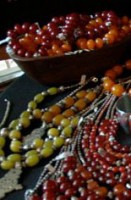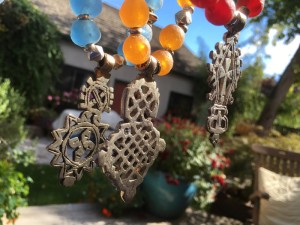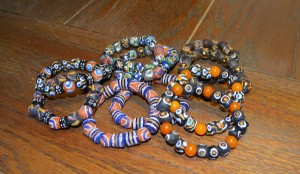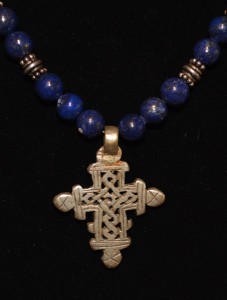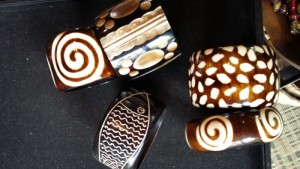News
Beads of Africa – The Story Continues…
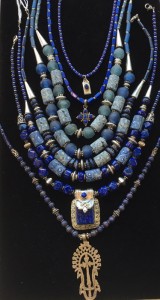 The word ‘bead’ comes from the Anglo-Saxon ‘bede’ meaning prayer. Beads have been associated with prayer by two-thirds of the world’s religions.
The word ‘bead’ comes from the Anglo-Saxon ‘bede’ meaning prayer. Beads have been associated with prayer by two-thirds of the world’s religions.
Today, all the beads found in Africa reached there because of extensive trade routes. There was tremendous trade from India, Italy, Amsterdam to the coast of Africa especially from Cam Bay, where for 5000 years agate, carnelian, and jasper have been mined and exported. Shipments of beads started arriving in Africa around the 4th century AD. Trade wind beads were found all over the Indian Ocean.
Slave Trade- What the world wanted from Africa was slaves, ivory and gold. There were two major slave markets:
On the East Coast- Arab slave traders from Zanzibar sold slaves that were destined for Persia and Europe.
On the West Coast- local chiefs sold slaves that went to the West Indies and the Southern states of North America.
Slavery ended in 1899, ending an ugly chapter spanning over 450 years of slavery, during which 15 million slaves were shipped to America. One of the best trade items were beads, which is how the majority of the beads ended up in Africa.
Types of Trade Beads that found their way to Africa and the United States:
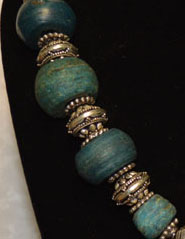 Hebron: Made in Hebron near Jerusalem using Dead Sea salts, are usually green, yellow and blue in color. Sometimes called the trade wind beads, they were brought in dhows pushed by the trade winds from the Indian Ocean as early as the 15th century. Arab and Indian traders brought these to the coast of Africa. Once there, these beads most likely were carried by rivers or camel caravans.
Hebron: Made in Hebron near Jerusalem using Dead Sea salts, are usually green, yellow and blue in color. Sometimes called the trade wind beads, they were brought in dhows pushed by the trade winds from the Indian Ocean as early as the 15th century. Arab and Indian traders brought these to the coast of Africa. Once there, these beads most likely were carried by rivers or camel caravans.
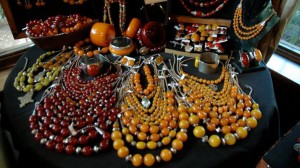 African Amber: Is the harden fossilized resin or sap of Ancient pine trees. There are several types and colors of amber. Most common colors are deep cherry red and a butterscotch yellow. You will also see a pale green and yellow, older beads can be a dark orange. Amber is warm to touch and light in weight. It has always been associated with beneficial effects on health. In Africa amber was a measure of family wealth and social status. Great medicinal and magical powers were attributed to it. The ancient Greeks believed that it was drops which had fallen from the sun.
African Amber: Is the harden fossilized resin or sap of Ancient pine trees. There are several types and colors of amber. Most common colors are deep cherry red and a butterscotch yellow. You will also see a pale green and yellow, older beads can be a dark orange. Amber is warm to touch and light in weight. It has always been associated with beneficial effects on health. In Africa amber was a measure of family wealth and social status. Great medicinal and magical powers were attributed to it. The ancient Greeks believed that it was drops which had fallen from the sun.
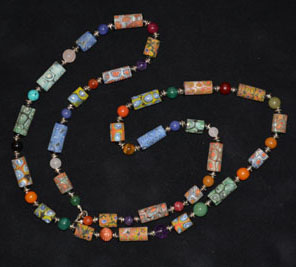 Trade Beads: Often called ‘Venetian Millefiore’ originated in the 17th century. They are composed of layers of cane glass all fused together at a high temperature on basin core. They usually have a floral pattern- hence the name ‘millefiori’ meaning a thousands flowers. They were used extensively for trading on the west coast of Africa. They were bartered for ivory, gold and yes even a single bead sometimes could buy a slave. At one time, trade beads were used as currency. These are the same type of beads that were part of the traded goods, which the Dutch bought the island of Manhattan with.
Trade Beads: Often called ‘Venetian Millefiore’ originated in the 17th century. They are composed of layers of cane glass all fused together at a high temperature on basin core. They usually have a floral pattern- hence the name ‘millefiori’ meaning a thousands flowers. They were used extensively for trading on the west coast of Africa. They were bartered for ivory, gold and yes even a single bead sometimes could buy a slave. At one time, trade beads were used as currency. These are the same type of beads that were part of the traded goods, which the Dutch bought the island of Manhattan with.
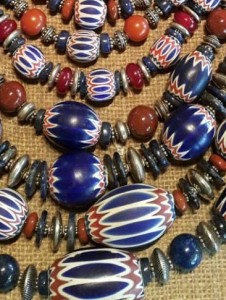 Chevron: The chevron is the most treasured of the antique beads, its blue, white and brick red in color, it was often referred to as the aristocrat of beads. Its composition is similar to that of the trade bead, the differences being the chevron always has a distinctive star pattern, because of this it is also known as the star or rosette bead. The chevron was so highly valued that only African chiefs or tribal leaders could own it. The African name for the chevron is ‘bakim-mutum’ meaning white man.
Chevron: The chevron is the most treasured of the antique beads, its blue, white and brick red in color, it was often referred to as the aristocrat of beads. Its composition is similar to that of the trade bead, the differences being the chevron always has a distinctive star pattern, because of this it is also known as the star or rosette bead. The chevron was so highly valued that only African chiefs or tribal leaders could own it. The African name for the chevron is ‘bakim-mutum’ meaning white man.
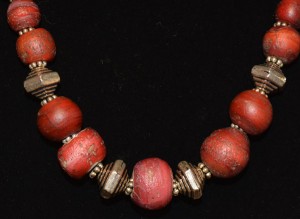 White Heart: A prized collector’s item. They are a compound bead composed of two layers. The inner core is almost always white or yellow, while the outer layer comes most commonly in various shades of red. White Hearts are also known by the intriguing name ‘cornaline d’Aleppo’ stemming from Aleppo, Syria. Smaller white hearts are known in West Africa as ‘rikiki’.
White Heart: A prized collector’s item. They are a compound bead composed of two layers. The inner core is almost always white or yellow, while the outer layer comes most commonly in various shades of red. White Hearts are also known by the intriguing name ‘cornaline d’Aleppo’ stemming from Aleppo, Syria. Smaller white hearts are known in West Africa as ‘rikiki’.
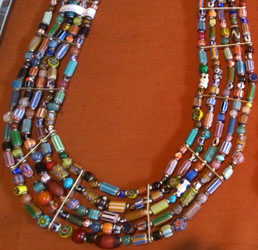 End of the Day Beads: These are made from leftovers of the day’s work, with a result that they are often very colorful. Round, colorful and heart shaped millefiori type beads were made in Nigeria (bida) the technique was probably brought by European glass experts. Jewelry creations will often include Samburu, Chevron and Ambassador beads. The African name is ‘massaga’
End of the Day Beads: These are made from leftovers of the day’s work, with a result that they are often very colorful. Round, colorful and heart shaped millefiori type beads were made in Nigeria (bida) the technique was probably brought by European glass experts. Jewelry creations will often include Samburu, Chevron and Ambassador beads. The African name is ‘massaga’
 Samburu: Beads such as the famous ‘Samburu’ communicate social status for both men and women of the Samburu tribes. A beautiful girl has many admirers who make gifts of these beads. A beautiful girl would have a substantial collection of necklaces, indicating her great desirability and thereby helping to secure a proposal of marriage. Samburu beads are believed to enhance the wearer’s fertility and are coveted for their ochre color. Rarer than diamonds, these beads are truly a girls best friend.
Samburu: Beads such as the famous ‘Samburu’ communicate social status for both men and women of the Samburu tribes. A beautiful girl has many admirers who make gifts of these beads. A beautiful girl would have a substantial collection of necklaces, indicating her great desirability and thereby helping to secure a proposal of marriage. Samburu beads are believed to enhance the wearer’s fertility and are coveted for their ochre color. Rarer than diamonds, these beads are truly a girls best friend.
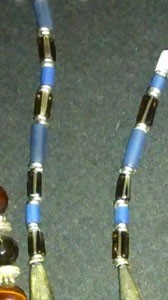 Ambassador Beads: Made in the pressed glass method. Known as Flanders. Specifically used as gifts for chiefs from European traders and ambassadors. Dutch blue opaque beads from Holland were machine made. Known to the Ndebele tribes of South Africa as Ambassador Beads. In 1901 Rhodesian chiefs gave them to witch doctors, who took them to sacared mountains for religious ceremonies. to ask advice from the great god of Matabele. They were worn by the chiefs who met David Livingstone at Victoria Falls in 1855 .
Ambassador Beads: Made in the pressed glass method. Known as Flanders. Specifically used as gifts for chiefs from European traders and ambassadors. Dutch blue opaque beads from Holland were machine made. Known to the Ndebele tribes of South Africa as Ambassador Beads. In 1901 Rhodesian chiefs gave them to witch doctors, who took them to sacared mountains for religious ceremonies. to ask advice from the great god of Matabele. They were worn by the chiefs who met David Livingstone at Victoria Falls in 1855 .
 Tuareg Cross: Tuareg Crosses, now worn by women as pendents around their necks, were originally worn by men, passed down from father to son when the boy reached puberty. The father would pass it on by saying “My son, I give you the four corners of the world, because one cannot know where one will die!” Most of the crosses designed are named after oasis towns between Agadez in Niger and the Hoggar Mountains to the north. Like other crosses it is used as currency to buy cattle, cloth or food in times of needs. An old saying in the Sahara Desert: ” If you were lost and pointed the cross towards the sun, it’s shadow would show you the direction of a watering hole.” This example to the left, is how you will find many Tuareg crosses these days, this one is strung with green and yellow Gashi beads and some silver.
Tuareg Cross: Tuareg Crosses, now worn by women as pendents around their necks, were originally worn by men, passed down from father to son when the boy reached puberty. The father would pass it on by saying “My son, I give you the four corners of the world, because one cannot know where one will die!” Most of the crosses designed are named after oasis towns between Agadez in Niger and the Hoggar Mountains to the north. Like other crosses it is used as currency to buy cattle, cloth or food in times of needs. An old saying in the Sahara Desert: ” If you were lost and pointed the cross towards the sun, it’s shadow would show you the direction of a watering hole.” This example to the left, is how you will find many Tuareg crosses these days, this one is strung with green and yellow Gashi beads and some silver.
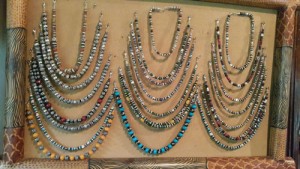 Camel Bone: Hand-carved and etched in Sub-Saharan Africa, camel bone is believed to bring great luck to desert tribes, as it is often their only means of sustenance in the desert.
Camel Bone: Hand-carved and etched in Sub-Saharan Africa, camel bone is believed to bring great luck to desert tribes, as it is often their only means of sustenance in the desert.
“Batik” Cow Bone/Horn: A local art form from Kenya, where the bone is dyed in “Batik” style with wax and dyes as on textiles.

